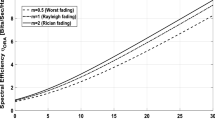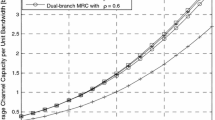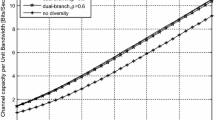Abstract
The spectral efficiency results for different adaptive transmission schemes over correlated diversity branches with unequal average signal to noise ratio (SNR) obtained so far in literature are not applicable for Nakagami-0.5 fading channels. In this paper, we investigate the effect of fade correlation and level of imbalance in the branch average received SNR on the spectral efficiency of Nakagami-0.5 fading channels in conjunction with dual-branch selection combining (SC). This paper derived the expressions for the spectral efficiency over correlated Nakagami-0.5 fading channels with unequal average received SNR. This spectral efficiency is evaluated under different adaptive transmission schemes using dual-branch SC diversity scheme. The corresponding expressions for Nakagami-0.5 fading are considered to be the expressions under worst fading conditions. Finally, numerical results are provided to illustrate the spectral efficiency degradation due to channel correlation and unequal average received SNR between the different combined branches under different adaptive transmission schemes. It has been observed that optimal simultaneous power and rate adaptation (OPRA) scheme provides improved spectral efficiency as compared to truncated channel inversion with fixed rate (TIFR) and optimal rate adaptation with constant transmit power (ORA) schemes under worst case fading scenario. It is very interesting to observe that TIFR scheme is always a better choice over ORA scheme under correlated Nakagami-0.5 fading channels with unequal average received SNR.











Similar content being viewed by others
Explore related subjects
Discover the latest articles, news and stories from top researchers in related subjects.References
Jiang, D., Xu, Z., Wang, W., Wang, Y., & Han, Y. (2015). A collaborative multi-hop routing algorithm for maximum achievable rate. Journal of Network and Computer Applications, 57, 182–191.
Memon, I., Hussain, I., Akhter, R., & Chen, G. (2015). Enhanced privacy and authentication: An efficient and secure anonymous communication for location based service using asymmetric cryptography scheme. Wireless Personal Communication, 84(2), 1487–1508.
Khatalin, S., & Fonseka, J. P. (2007). Channel capacity of dual-branch diversity systems over correlated Nakagami-m fading with channel inversion and fixed rate transmission scheme. IET Communications, 1(6), 1161–1169.
Khatalin, S., & Fonseka, J. P. (2006). Capacity of correlated Nakagami-m Fading Channels with Diversity Combining Techniques. IEEE Transactions on Vehicular Technology, 55(1), 142–150.
Goldsmith, A. J., & Varaiya, P. P. (1997). Capacity of fading channels with channel side information. IEEE Transactions on Information Theory, 43(6), 1986–1992.
Barrow, B. B. (1963). Diversity combination of fading signals with unequal mean strengths. IEEE Transactions on Communication system, CS–11, 73–78.
Halpern, S. W. (1977). The effect of having unequal branch gains in practical predetection diversity systems for mobile radio. IEEE Transactions on Vehicular Technology, VT–26, 94–105.
Alouini, M. S., & Goldsmith, A. J. (1997). Capacity of Nakagami multipath fading channels. Proceedings of the IEEE Vehicular Technology Conference (pp. 358–362), Phoenix, AZ.
Alouini, M. S., & Goldsmith, A. J. (1999). Capacity of Rayleigh fading channels under different adaptive transmission and diversity-combining techniques. IEEE Transactions on Vehicular Technology, 48(4), 1165–1181.
Bithas, P. S., & Mathiopoulos, P. T. (2009). Capacity of correlated generalized gamma fading with dual-branch selection diversity. IEEE Transactions on Vehicular Technology, 58(9), 5258–5263.
Alouini, M. S., & Goldsmith, A. J. (2000). Adaptive modulation over Nakagami fading channels. Wireless Personal Communication, 13, 119–143.
Subadar, R., & Sahu, P. R. (2009). Capacity analysis of dual-SC and-MRC systems over correlated Hoyt fading channels. IEEE Conference, TENCON (pp. 1–5).
Hamdi, K. A. (2008). Capacity of MRC on correlated Rician fading channels. IEEE Transactions on Communications, 56(5), 708–711.
Khatalin, S., & Fonseka, J. P. (2006). On the channel capacity in Rician and Hoyt fading environment with MRC diversity. IEEE Transactions on Vehicular Technology, 55(1), 137–141.
Petrovic, I., Stefanovic, M., Spalevic, P., Panic, S. R., & Stefanovic, D. (2013). Outage analysis of selection diversity over Rayleigh fading channels with multiple co-channel interferers. Telecommunication System, 52(1), 39–50.
Seyfi, M., Muhaidat, S., & Liang, J. (2012). Amplify-and-forward selection cooperation over Rayleigh fading channels with imperfect CSI. IEEE Transaction on Wireless Communication, 11(1), 199–209.
Enserink, S., & Fitz, M. P. (2013). Estimation of constrained capacity and outage probability in lognormal channels. IEEE Transactions on Vehicular Technology, 62(1), 399–404.
Rezki, Z., & Alouini, M. S. (2012). On the capacity of Nakagami-m fading channels with full channel state information at low SNR. IEEE Wireless Communication Letter, 1(3), 253–256.
Pena-Martin, J. P., Romero-Jerez, J. M., & Tellez-Labao, C. (2013). Performance of TAS/MRC wireless systems under Hoyt fading channels. IEEE Transaction on Wireless Communication, 12(7), 3350–3359.
Subadar, R., & Sahu, P. R. (2010). Capacity analysis of dual-SC and -MRC systems over correlated Nakagami- \(m\) fading channels with non-identical and arbitrary fading parameters. IEEE Conference (NCC-2010) (pp. 1–5).
Yilmaz, F. & Alouini, M. S. (2012). Novel asymptotic results on the high-order statistics of the channel capacity over generalized fading channels. In IEEE 13th International Workshop on Signal Processing Advances in Wireless Communications (SPAWC-2012) (pp. 389–393).
Hasan, M. I., & Kumar, S. (2014). Channel capacity of dual-branch maximal ratio combining under worst case of fading scenario. WSEAS Transactions on Communications, 13, 162–170.
Hasan, M. I., & Kumar, S. (2015). Average channel capacity of correlated dual-branch maximal ratio combining under worst case of fading scenario. Wireless Personal Communication, 83(4), 2623–2646.
Hasan, M. I., & Kumar, S. (2015). Average channel capacity evaluation for selection combining diversity schemes over Nakagami-0.5 fading channels. International Journal of Communication Networks and Information Security (IJCNIS), 7(2), 69–79.
Hasan, M. I., & Kumar, S. (2015). Spectral efficiency evaluation for selection combining diversity schemes under worst case of fading scenario. International Journal of Communication Networks and Information Security (IJCNIS), 7(3), 123–130.
Brennan, D. (2003). Linear diversity combining techniques. Proceedings of IEEE, 91(2), 331–354.
Simon, M. K., & Alouini, M. S. (2005). Digital communication over fading channels. New York: Wiley.
Fodele, G., Izzo, I., & Tanda, M. (1995). Dual diversity reception of M-ary DPSK signals over Nakagami fading channels. In Proceedings of the IEEE International Symposium Personal, Indoor, and Mobile Radio Communications (pp. 1195–1201) Toronto.
Gradshteyn, I. S., & Ryzhik, I. M. (2000). Tables of integrals, series, and products. New York: Academic Press.
Wolfram. (2015). The Wolfram functions site. Retrieved from http://functions.wolfram.com.
Author information
Authors and Affiliations
Corresponding author
Rights and permissions
About this article
Cite this article
Hasan, M.I., Kumar, S. Spectral efficiency of dual diversity selection combining schemes under correlated Nakagami-0.5 fading with unequal average received SNR. Telecommun Syst 64, 3–16 (2017). https://doi.org/10.1007/s11235-016-0152-8
Published:
Issue Date:
DOI: https://doi.org/10.1007/s11235-016-0152-8




